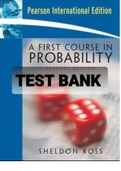, Solutions Manual
A First Course in
PROBABILITY Seventh Edition
Sheldon Ross
Prentice Hall, Upper Saddle River NJ 07458
, Table of Contents
Chapter 1 ..............................................................................1
Chapter 2 ..............................................................................10
Chapter 3 ..............................................................................20
Chapter 4 ..............................................................................46
Chapter 5 ..............................................................................64
Chapter 6 ..............................................................................77
Chapter 7 ..............................................................................98
Chapter 8 ..............................................................................133
Chapter 9 ..............................................................................139
Chapter 10 ............................................................................141
, Chapter 1
Problems
1. (a) By the generalized basic principle of counting there are
26 ⋅ 26 ⋅ 10 ⋅ 10 ⋅ 10 ⋅ 10 ⋅ 10 = 67,600,000
(b) 26 ⋅ 25 ⋅ 10 ⋅ 9 ⋅ 8 ⋅ 7 ⋅ 6 = 19,656,000
2. 64 = 1296
3. An assignment is a sequence i1, …, i20 where ij is the job to which person j is assigned. Since
only one person can be assigned to a job, it follows that the sequence is a permutation of the
numbers 1, …, 20 and so there are 20! different possible assignments.
4. There are 4! possible arrangements. By assigning instruments to Jay, Jack, John and Jim, in
that order, we see by the generalized basic principle that there are 2 ⋅ 1 ⋅ 2 ⋅ 1 = 4 possibilities.
5. There were 8 ⋅ 2 ⋅ 9 = 144 possible codes. There were 1 ⋅ 2 ⋅ 9 = 18 that started with a 4.
6. Each kitten can be identified by a code number i, j, k, l where each of i, j, k, l is any of the
numbers from 1 to 7. The number i represents which wife is carrying the kitten, j then
represents which of that wife’s 7 sacks contain the kitten; k represents which of the 7 cats in
sack j of wife i is the mother of the kitten; and l represents the number of the kitten of cat k in
sack j of wife i. By the generalized principle there are thus 7 ⋅ 7 ⋅ 7 ⋅ 7 = 2401 kittens
7. (a) 6! = 720
(b) 2 ⋅ 3! ⋅ 3! = 72
(c) 4!3! = 144
(d) 6 ⋅ 3 ⋅ 2 ⋅ 2 ⋅ 1 ⋅ 1 = 72
8. (a) 5! = 120
7!
(b) = 1260
2!2!
11!
(c) = 34,650
4!4!2!
7!
(d) = 1260
2!2!
(12)!
9. = 27,720
6!4!
10. (a) 8! = 40,320
(b) 2 ⋅ 7! = 10,080
(c) 5!4! = 2,880
(d) 4!24 = 384
Chapter 1 1




